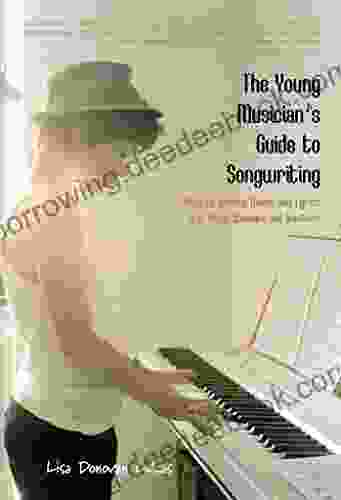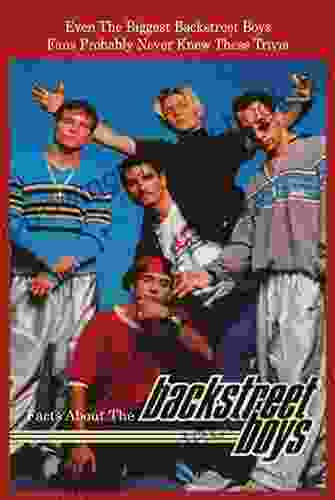The Young Musician's Guide to Songwriting

1. Finding Inspiration
Every great song begins with a spark of inspiration. Whether it's a personal experience, a passing melody, or a poignant line of poetry, finding that initial spark is crucial to kickstart the songwriting process. Here are some tips to help you ignite your creative fire:
4.6 out of 5
| Language | : | English |
| File size | : | 28835 KB |
| Text-to-Speech | : | Enabled |
| Screen Reader | : | Supported |
| Enhanced typesetting | : | Enabled |
| Word Wise | : | Enabled |
| Print length | : | 249 pages |
- Immerse yourself in music: Listen to a wide range of genres and styles to expand your musical horizons. Pay attention to the structure, melody, and lyrics of songs that resonate with you.
- Keep a journal: Note down any musical ideas, lyrical fragments, or experiences that inspire you. This will serve as a valuable source of inspiration when you need it.
- Experiment with different instruments: Playing various instruments can help you discover new sounds and melodies that might not have come to you otherwise.
- Collaborate with others: Sharing ideas and working with other musicians can often lead to unexpected and inspiring collaborations.
2. Understanding Music Theory
While not essential, having a basic understanding of music theory can greatly enhance your songwriting abilities. It provides a framework for understanding the structure, harmony, and melody of music. Here are some key concepts to familiarize yourself with:
- Scales and chords: Scales are the building blocks of melody, while chords provide the harmonic foundation. Learning about different scales and chords will help you create more sophisticated and interesting musical arrangements.
- Rhythm and meter: Rhythm refers to the timing and duration of notes, while meter divides music into regular units of time. Understanding rhythm and meter will help you write songs that groove and flow well.
- Form and structure: Most songs follow a basic structure, such as verse-chorus-bridge. Understanding different song forms will help you organize your ideas and create a coherent composition.
3. Crafting Melody and Harmony
A memorable melody is the heart of any great song. Here are some tips for creating melodies that will capture the listener's attention:
- Start with a simple idea: Begin with a short, catchy melody that you can easily remember and sing. Elaborate on it gradually by adding variations and embellishments.
- Use repetition and sequence: Repeating melodic patterns creates a sense of familiarity and makes your melodies more memorable. Use sequences to create a sense of movement and development.
- Explore different intervals: Vary the distance between notes in your melodies to create interest and avoid monotony. Experiment with different intervals, such as thirds, fifths, and octaves.
Harmony supports and complements the melody, creating a richer and more satisfying musical experience. Consider the following when crafting harmonies:
- Choose chords that fit the melody: The chords you use should support and enhance the melody without overpowering it. Experiment with different chord progressions to find the ones that best complement your melody.
- Use tension and release: Creating tension and release in your harmonies can add drama and interest to your songs. Use dissonant chords to create tension and resolve them with consonant chords for a satisfying release.
- Experiment with different voicings: The way you arrange your chords, or "voicing," can greatly affect the sound of your harmony. Try inverting chords or using different voicings to create unique and interesting sounds.
4. Writing Lyrics
Lyrics are the words that bring your music to life. They convey your thoughts, feelings, and stories in a way that resonates with listeners. Here are some tips for writing effective lyrics:
- Start with a story: Think about what you want to communicate with your song and create a narrative that supports your theme.
- Choose words carefully: Every word you use should contribute to the overall message and tone of your song. Avoid clichés and strive for originality and specificity.
- Use rhyme and repetition: Rhyme can create a sense of flow and memorability, while repetition can emphasize important lyrics and reinforce your message.
- Experiment with different forms: There are many different lyrical forms, such as sonnets, haikus, and free verse. Experiment with different forms to find the one that best suits your song's message.
5. Arranging and Recording
Once you have written the core of your song, it's time to arrange it and bring it to life. Arranging involves bringing together all the musical elements—melody, harmony, lyrics, and instrumentation—into a cohesive whole. Here are some factors to consider when arranging your song:
- Instrumentation: Choose instruments that complement your song's style and mood. Consider the timbre, range, and dynamics of each instrument.
- Dynamics: Vary the volume and intensity of your song to create contrast and interest. Use a mix of loud and soft sections to build tension and release.
- Texture: The texture of your song refers to the overall sound quality and density. Experiment with different combinations of instruments, rhythms, and harmonies to create a rich and engaging soundscape.
Recording your song is the next step in bringing your vision to life. Consider the following tips when recording:
- Choose a good recording environment: Find a quiet and acoustically treated space to record in. This will help reduce background noise and improve the quality of your recording.
- Use quality equipment: Invest in a good microphone and recording software. This will make a significant difference in the overall sound of your recording.
- Experiment with different takes: Don't settle for the first take. Record multiple takes and experiment with different interpretations of your song. This will give you options to choose from during the mixing process.
6. Mixing and Mastering
Mixing and mastering are the final steps in the songwriting process. Mixing involves balancing the volume, EQ, and panning of each track in your recording to create a cohesive and polished sound. Mastering is the process of finalizing the overall sound of your song, making it ready for distribution and listening.
While mixing and mastering can be complex processes, there are some basic techniques you can use to improve the sound of your recordings:
- Use EQ to balance the frequencies: EQ, or equalization, allows you to adjust the volume of specific frequency ranges in your recording. Use EQ to balance the instruments and vocals and remove any unwanted frequencies.
- Use compression to control dynamics: Compression reduces the dynamic range of your recording, making the loud parts quieter and the quiet parts louder. Use compression to add punch and clarity to your mix.
- Use reverb and delay to create space and depth: Reverb and delay can add a sense of space and depth to your recordings. Use them sparingly to avoid making your mix sound muddy or cluttered.
Songwriting is a journey of exploration, creativity, and self-expression. By embracing the techniques and principles outlined in this guide, you can embark on your songwriting journey with confidence and a solid foundation of knowledge. Remember, practice, experimentation, and a relentless pursuit of musical growth are the keys to becoming a successful young musician.
4.6 out of 5
| Language | : | English |
| File size | : | 28835 KB |
| Text-to-Speech | : | Enabled |
| Screen Reader | : | Supported |
| Enhanced typesetting | : | Enabled |
| Word Wise | : | Enabled |
| Print length | : | 249 pages |
Do you want to contribute by writing guest posts on this blog?
Please contact us and send us a resume of previous articles that you have written.
 Book
Book Novel
Novel Page
Page Text
Text Story
Story Genre
Genre Newspaper
Newspaper Paragraph
Paragraph Bookmark
Bookmark Shelf
Shelf Foreword
Foreword Synopsis
Synopsis Footnote
Footnote Codex
Codex Tome
Tome Classics
Classics Library card
Library card Narrative
Narrative Memoir
Memoir Encyclopedia
Encyclopedia Dictionary
Dictionary Thesaurus
Thesaurus Catalog
Catalog Card Catalog
Card Catalog Borrowing
Borrowing Stacks
Stacks Archives
Archives Periodicals
Periodicals Study
Study Reserve
Reserve Journals
Journals Reading Room
Reading Room Rare Books
Rare Books Interlibrary
Interlibrary Literacy
Literacy Storytelling
Storytelling Awards
Awards Reading List
Reading List Book Club
Book Club Textbooks
Textbooks Dave P Fisher
Dave P Fisher Tom Brokaw
Tom Brokaw Salena Zito
Salena Zito Jon Saphier
Jon Saphier Troy Nelson
Troy Nelson James G Blight
James G Blight Agnes Sullivan
Agnes Sullivan Judy Leigh Moore
Judy Leigh Moore Joe Pearson
Joe Pearson Christopher J Perkins
Christopher J Perkins Gary Tzu
Gary Tzu Susannah B Lewis
Susannah B Lewis Chad Craft
Chad Craft Robert Reade
Robert Reade Ila France Porcher
Ila France Porcher Jonathan Biss
Jonathan Biss April Parker
April Parker Jean Cheng Gorman
Jean Cheng Gorman Summer Lane
Summer Lane Jackie Polzin
Jackie Polzin
Light bulbAdvertise smarter! Our strategic ad space ensures maximum exposure. Reserve your spot today!

 John SteinbeckThe Ultimate Study Guide for Jonathan Franzen's The Corrections: An In-Depth...
John SteinbeckThe Ultimate Study Guide for Jonathan Franzen's The Corrections: An In-Depth...
 Samuel Taylor ColeridgeWitches Vs Necromancers Vs Dragons: An Epic Battle Under Realm Academy
Samuel Taylor ColeridgeWitches Vs Necromancers Vs Dragons: An Epic Battle Under Realm Academy Adrien BlairFollow ·2.5k
Adrien BlairFollow ·2.5k Allan JamesFollow ·7.2k
Allan JamesFollow ·7.2k Bobby HowardFollow ·8.6k
Bobby HowardFollow ·8.6k Elton HayesFollow ·19k
Elton HayesFollow ·19k Carlos FuentesFollow ·16.3k
Carlos FuentesFollow ·16.3k Michael SimmonsFollow ·4k
Michael SimmonsFollow ·4k Jorge AmadoFollow ·5.6k
Jorge AmadoFollow ·5.6k Cooper BellFollow ·15.5k
Cooper BellFollow ·15.5k

 Darius Cox
Darius CoxThe Gathering Pacific Storm: An Epic Struggle Between...
The Gathering...

 Hugo Cox
Hugo CoxHow CIA-Contra Gangs and NGOs Manufacture, Mislabel, and...
In the annals of covert operations, the CIA's...

 Finn Cox
Finn CoxDr. Brandt's Billionaires Club Series: The Ultimate...
A Journey into the Pinnacle of...

 Isaac Asimov
Isaac AsimovCurrent Affairs Daily Digest 20180730 30th July 2024
National ...

 Felix Carter
Felix CarterBroadway Celebrates The Big Apple Over 100 Years Of Show...
Broadway Celebrates the Big Apple: Over 100...

 Beau Carter
Beau CarterThe Big Book of Flute Solos: A Comprehensive Collection...
If you're a flute player,...
4.6 out of 5
| Language | : | English |
| File size | : | 28835 KB |
| Text-to-Speech | : | Enabled |
| Screen Reader | : | Supported |
| Enhanced typesetting | : | Enabled |
| Word Wise | : | Enabled |
| Print length | : | 249 pages |








